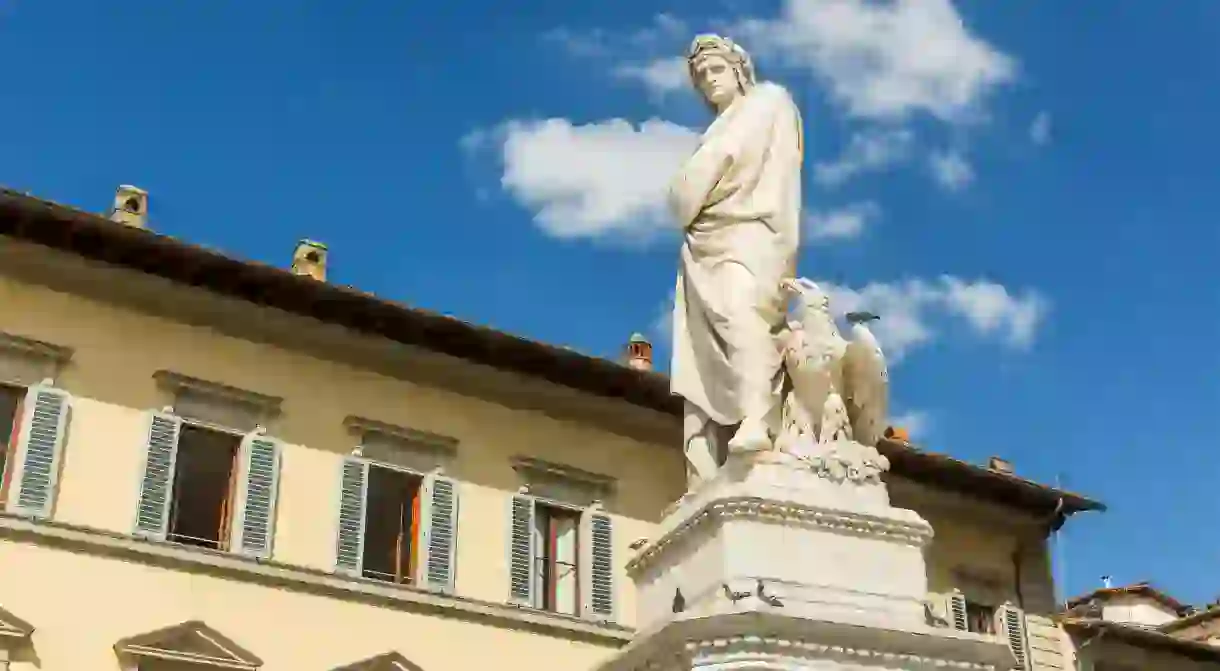Discovering the Florence of Poet Dante Alighieri

Dante Alighieri, author of The Divine Comedy and father of the Italian language, is Florence’s cherished native son. Following his exile from the city in 1302 however, the poet’s regard for his hometown was less than favourable. Here, discover Dante’s complicated relationship with his native Florence, and explore his home and haunts in the Tuscan capital.
It’s near impossible to visit Florence without stumbling across something Dante-related. Tributes to the city’s native poet are quite literally on every corner – there are 34 plaques dotted around the centre of Florence inscribed with quotes from The Divine Comedy, each relating, in some way, to the location in which they’re placed. Hotels, streets and restaurants are named after Dante, and his likeness is recreated in several sculptures and artworks across the city.
Dante’s regard for his hometown, however, was less than favourable. The poet, born in Florence in 1265, lived in the city for almost four decades before his political ideologies landed him in exile in 1302. It was only after leaving Florence that he created what would go on to be his magnum opus, The Divine Comedy, throughout which there are frequent references to the city and its people – many of them condemnatory.
If you were to trace the plaques across the city’s historic centre, you’d get an idea of the Florence of Dante’s day. On Via del Corso for example, there’s a plaque on the former site of Filippo Argenti’s home, quoting a passage in which the politician – an enemy of Dante’s who opposed his return to Florence and (allegedly) once slapped him – is condemned to the Fifth Circle of Hell. There are also a handful of locations meaningful to the poet that bear plaques. On the ground next to the Baptistry of San Giovanni, site of Dante’s christening and one of Florence’s most iconic buildings, is a plaque reading ‘in my beautiful San Giovanni’, taken from Dante’s Inferno.

Dante never returned to Florence – going home would have been a death sentence. He went on to reside in various Italian cities before he passed away while living in Ravenna, a city near the northern coast of the Adriatic. Though Ravenna is where Dante’s tomb can be found, it’s in Florence that the poet spent most of his life.
From the site of his birthplace to the church where he allegedly first laid eyes on his beloved Beatrice, take a walk through Dante’s Florence via the five pitstops below.
Museo Casa di Dante
Museum, Historical Landmark

The first stop on any Dante-themed Florence itinerary should be the site of his birth. The famous Florentine poet was born on this spot in 1265, and a house was built on the location of the medieval Alighieri family homes to honour his legacy. The three-storey building, located just off Via Dante Alighieri, was converted into a museum displaying artefacts and replicas from the life and times of Dante.
Chiesa di Santa Margherita
Church, Cathedral

Across the street from Dante’s birthplace is this small Roman Catholic church. Many significant moments in Dante’s life are said to have taken place here; it was in the church that he allegedly first saw his love and muse Beatrice Portinari, and also where he is thought to have married Gemma Donati, mother of his four children. Today, the spirit of Beatrice acts as something of an agony aunt; visitors commonly leave letters praying for luck in their love lives at her shrine within the church.
Piazza del Duomo
Historical Landmark
The tale of Dante’s stone is told time and time again by Florentines. The great Italian poet is said to have spent many summer evenings perched on an old rock between Piazza delle Pallottole and Piazza del Duomo, writing love poems and enjoying the summer breeze. On Piazza delle Pallottole today is Sasso di Dante, a restaurant named after the historic site, but if you want to find the exact spot where Dante sat you’d have to pop round the corner to the south side of the Duomo. There, fixed on the wall between two shops, is a marble plaque reading ‘Sasso di Dante’ – it’s here that Dante’s favourite seat would’ve been located.
Palazzo Vecchio
Building, Museum, Historical Landmark

Ponte Santa Trinita
Bridge














